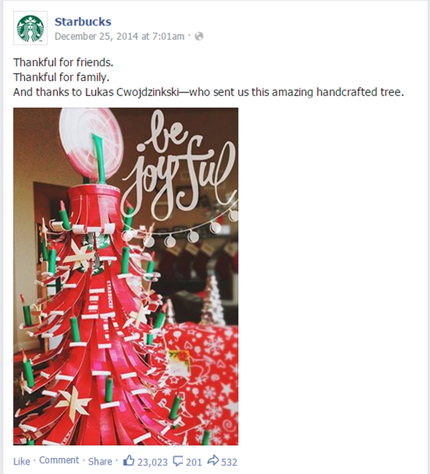Erik Qualman's Blog, page 571
January 22, 2015
The Way Data is Changing Small (and Large) Businesses

Data is the big transformative element of society today. We are living in post-industrial world – and it means that it is the data, not material goods, that lies at the basis of, well, everything. But just because we have a lot of data it doesn’t mean we know what to do with it.
Which means that those who know what to do with it are always going to be a step ahead of those who don’t.
As a business owner, the better you are at correctly interpreting data, the easier it is for you to adapt your business to the ever-changing modern world. Here are ways you can do it.
1. ERP
Enterprise Resource Planning is a function that can be performed by specialists, software, or some combination of the two. The last is usually the arrangement that is struck. There are a billion different data points, many pools of records and observations associated with your particular industry.
By looking closely at your business’s place in this industry, ERP can chart a course for you over the next month, year, decade. ERP allows businesses to be more agile than even the most experienced leaders could manage on their own. No one has the level of perception that real data provides, and ERP is a way of channeling it into incisive, actionable advice.
2. Data Analysis for Retailers
Data is currently at the crux of change in online retail. Because all of the steps of the customer process are recorded in web retailing, these data points have amassed into a huge wealth of knowledge. Retailing giants like Amazon use this data to determine what products you are likely to buy, even if you haven’t searched for them yet.
Their skill at doing this, and at pricing items so that you are most likely to buy them, has enabled them to build the biggest web retailing empire in history. In order to access their data mine, smaller retailers have given them a share of their profits, just to be able to set up shop under their digital roof.
This changes when data providers offer the same level of data access and analysis to retailers outside of the Amazon bubble. Some new companies, like Wiser, have emerged to do just this, and are providing retailers with information that will let them offer a customer the right product at the right time at the right price.
This may not lead to a total democratization of online retail, but it will enable more dynamic pricing wherever goods are sold, and this can only increase diversity in the sphere – something that is likely to be good for retailers and consumers alike.
3. Exploring Trends with Google
Google is probably one of the biggest players in information playfield; by being by far the most widely used and popular search engine it manages to collect, analyze and store a veritable goldmine of information. And, what is more important, it offers completely free access to it, which may provide you with priceless business insights.
Enter Google Trends – a free tool allowing you to study search trends, see what is popular, which keywords are used with other words and how often, where this or that search is more popular and so on. For a businessman with imagination it opens up a highway to innumerable opportunities.
4. Studying numerical data about your website
If your website plays an important role in the life of your business (and if you live in 2015, chances are that it does), you probably often wonder who are all these people that visit it, according to traffic charts.
Fortunately, today there is a million ways to get quite accurate data concerning it. Take, for example, Quantcast – it is a tool that allows you to simply type in the name of a website and get a report (free of charge!) with detailed information on its visitors: how many they are, what is their demographic make-up, where they live, how many of them use mobile devices and so on. Priceless information at no cost – what can be better?
5. Tap into Credit Card Transactions
Sounds illegal? Well, there are ways to do it in full accordance with the law, but also without paying through the nose.
Credit card transactions contain a fascinating amount of data that any businessman would be happy to get, but until recently access to it has been limited to large companies ready to go into a great deal of expense.
Luckily for you, today there are companies like Tranzlogic that make it possible even for a small business to tap into this source of information and reap all its benefits.
Data is going to change our lives in unpredictable ways. With the election and things like the Moneyball book, data is part of our cultural conversation. It is giving us context that is changing the way we see the world, and our own place in it. The way it will change business is unknown, but these changes will certainly develop along the above-mentioned channels.
[image error]
January 21, 2015
Find the Social Solution to Better Credit

Whether you run a business or work for one, your finances are likely your top priority from day to day.
For the former, running a company takes intestinal fortitude and many other things.
If you’re good when it comes to overseeing money, your business can turn out to be quite successful. On the flip side, if handling and dispersing funds is not your strong suit, you could find yourself one of many small businesses that ultimately go under.
For those individuals not running a business but working hard to stay ahead financially, their credit history can go a long way in determining if they have money while they’re working and ultimately when their working days are behind them.
So, how can you take advantage of all social media has to offer when it comes to learning how to manage your finances and more importantly, acquire and maintain a competitive credit score?
Educate Yourself on Finances
Face it; while many people claim to be financial gurus, those who truly are tend to be few and far between.
The key to properly running a small business and/or managing one’s own finances oftentimes boils down to education.
A prime example of this is one’s credit history.
Companies such as CreditSesame.com can help you with financial information pertaining to your monthly credit score, reviews of your entire credit and loan portfolios and much more. By using these kinds of companies, you have a better idea of where your credit profile stands and what you may need to do to improve on it.
Unless you live in a world where you never plan to buy a car, a home, take out a loan etc., your credit score and its history do in fact matter. As all too many people have discovered, a bad credit score can prohibit them from making key purchases in their lives.
This is where social media can play a major role in helping folks improve their financial standing in the eyes of banks, credit unions, loan providers, credit card companies and more.
Among the various ways to use social media for a better financial education:
Educate yourself on credit cards – For starters, don’t be applying for multiple credit cards if you’re not very good at handling money. The truth is that paying for items hurts more when you use your own cash than a piece of plastic. Credit cards should be used more for bigger ticket items such as car repairs, purchases for a small business like computers and printers, and trips (that doesn’t mean you should be jet-setting around the world and running up a big credit card tab). Visit various financial sites and their Facebook and Twitter pages to learn how to use credit wisely;
Learn about identity theft – With the usage of credit cards unfortunately comes fraud and identity theft. Turn to social media pages from financial sites again (along with the media and law enforcement) to learn about credit card scams and more. Federal, state and local agencies will oftentimes turn to their social media pages to alert the public when a credit card/identity theft scam is underway. An educated consumer is much less likely to become a victim than someone who pays little or no attention to what is going on in the world.
Use social media to educate yourself on credit history, credit scores, credit card fraud and more whether you run a small business or not.
When you’re better educated, you stand to take credit for being a better individual when it comes to finances.
[image error]
Is the Success of Cute Kitty Photos and Videos on Facebook Real?

Do you want to know which category works best on Facebook? And which works the worst? Which countries have more organic and viral reach? And what do users engage more with?
The infographic below analyses hundreds of thousands of publications within Facebook pages, filtering by number of fans, category and country to draw conclusions about what is working better on the social network during 2014. The results tell us that Fan pages in the category ‘Photographers‘ work the best, while Software Pages or Eletronics get the lowest percentage of organic and viral reach respectively. Moreover, the category with the highest engagement in 2014 was ‘Pet’ with 19,57%. So, maybe the answer to whether it is real the success of cute kitties on Facebook is yes (this also applies to other pets).
This document is useful for social media professionals and agencies who often work with fan pages for very different types of customers, frequently without knowing the reach and engagement that can be achieved. This infographic gives a general idea of what works and what does not internationally.
To create this infographic, Cool Tabs has used its free service, called Page Performance, which checks the performance of your site and calculates your organic reach, viral reach, engagement and the number of people talking about your page (among other KPIs) and tells you whether you are above or below the average for pages with the same number of fans as yours.
Additionally, with the premium version, you can compare the results of your Fan Page with your competitors’ pages, as you will be able to filter by category and country, in order to find out the percentages for the most similar Facebook pages to that of your business.
Do you know which country won the Facebook gold medal according to this tool? To find out, take a look at this infographic about Fan Pages in 2014:
[image error]
3 Scientifically Proven Reasons Why Collaboration Empowers Your Social Media Marketing

Most organizations have just one person (in-house or outsourced) that manages their social media efforts. And that person would not only handle social media updates; there would probably be a bunch of other things on the side that they would also look after. Or there would be two people handling social media, because how much more can you spend on a medium whose results are hazy at best, right? Wrong.
My simple question here is, “If a discipline has ‘social’ in its name itself, how can it NOT be managed ‘socially’ or in other words, by a team?”
Social media deals with people, not just one person. Getting the inputs and perspectives of more than one individual helps your brand sound like a “person” – someone your target audience would like to be friends with, as opposed to a stodgy corporate stooge that one would run a mile from.
I don’t suggest that smart ideas and great campaigns only happen inside closed boardrooms with a large team hacking away all night long. Indeed, 78% of large companies have a dedicated social media team. Using an integrated, process-oriented setup where tasks are strategized with a project management service like Basecamp, and team conversations flow through (and are captured) within an email collaboration tool like Grexit, the resulting synergies are far superior to individual outcomes.
Don’t take my word on why teamwork can be so awesome for your social media marketing. Here are some strategies that have been found and corroborated across the inter-webs.
1. Collaboration Leads to Inspired Action
Since childhood we have been told that two heads are better than one. In corporate setups however, two heads often mean twice the professional rivalry, twice the jealousies, twice the politicking. A real productivity killer, or so you would imagine.
Emily Amanatullah, from the McCombs School of Business, coauthored a study with Francis Flynn of Stanford University, on the impact of high performers on the performance of those working with them.
Amanatullah and Flynn studied the performance of regular golfers in the presence of golfing stars and found that the mere presence of a high performer, inspired the average Joes to put in that extra bit of effort and produce better results. This inspired performance does not get left behind on the golfing greens.
The duo found that even in the office, high performers raise the bar, motivating team mates to do better. Weaker individuals emulate the stars and learn tips and tricks from them thus increasing overall productivity of the team. The catch here is that when star performers are in direct competition with their lesser gifted colleagues, they end up psyching out the latter.
Have a social media queen bee on your team? Someone with thousands of followers on Twitter, a diva with her own guest boards across Pinterest? Chances are, the rest of your team will be busy taking notes and honing their own skills on the job. The result? A team that learns from the best and helps your brand put its best foot forward.
2. Competition Makes You Pull Up Your Socks
John Van Reenen from the Center for Economic Performance (CEP) at the London School of Economics writes about the elevating effects of competition on organizational productivity. The CEP carried out a series of studies that showed that growth in competition led to improved and productivity. The best part? This spike in productivity continues as competition persists.
Another study by the CEP scrutinized over 3000 major innovations in the United Kingdom since the last World War. The results were telling. On an average, competition promoted innovation across the entire sample set the researchers had chosen.
How does this relate to social media marketing? Simple.
While collaborating with team members from across the organization, a barely hidden competitive streak is a given. This competition propels team members to go one up on each other by performing better than the next guy. The sum ends up being greater than its parts, leading to some real fireworks on social media (in a good way, of course!)
3. User Generated Content Connects You to Your Audience
Social media marketing is not about your brand saying stuff TO your target audience via social platforms. It’s about having a conversation WITH your fans and engaging with them on a one on one basis. This is the place to descend from your ivory tower, lower the drawbridge and allow your audience to come on board as co-creators, co-owners of your brand.
Research has shown over and over again that users trust user generated content WAY MORE than any amount of marketing spiel you put out there. Nielsen reports that “Ninety-two percent of consumers around the world say they trust earned media, such as word-of-mouth and recommendations from friends and family, above all other forms of advertising”
Brands from Coca-Cola to GE to Starbucks are testimony to the soaring power of user collaborations and user generated content. A great fan tweet or image endorsing your brand does more to make your brand more relatable to users than hundreds of salesy posts ever can.
Source: Starbucks showcases UGC on its Facebook page
Want some numbers to bolster your belief in the power of user collaboration?
Curalate carried out a study about engagement rates on Pinterest and found that over 70% of engagement on Pinterest comes from community pins, not brand driven pins.
Social intelligence provider Syncapse found that 85% of brand fans on Facebook recommend brands they like to others.
A study by public relations firm Cone Communications found that 87% of users agree that favorable reviews for a product / service confirms their decision to buy it
From asking for product reviews to creating photo contests, from asking users to tweet a selfie using your product to honoring users by showcasing the content they generate on your social pages, the options to bring the “user angle” into your social media marketing are endless.
Parting Words
In my experience, the best social media results are achieved when a crackling team comprising diverse characters comes together to make marketing magic. Be it that brilliant engineer who cracked a tough product fix or that colorful super fan who can’t stop raving about your brand, bring them on board to take your social media marketing from “satisfactory” to “superb!”
[image error]
January 20, 2015
A Social Media Campaign Used to Promote Social Good

Buzzfeed recently posted this article with photos from the newest installment of Duke University’s “You Don’t Say” social media campaign. This social media campaign highlights language that is offensive to sexual and gender minorities. Buzzfeed user Daniel Kort says, “In this installment of the “You Don’t Say?” Campaign, Duke student-athletes are speaking out on why they don’t say certain words that are marginalizing to particular identities. Check it out on Facebook and Twitter!” Below are a few images from the campaign.

Follow the You Don’t Say? Campaign on Facebook and Twitter for more inspiring photos about the power of language.
Photos by Shayan Asadi/You Don’t Say? Campaign.
[image error]
Social Networking Opens Up Myriad Recycling Ways

 Sometimes it’s a challenge to know what to recycle or not and when you know recycling becomes easier.
Sometimes it’s a challenge to know what to recycle or not and when you know recycling becomes easier.
Recycling organizations can reach out to customers in more than one way, including social media. With some reminders and nudges, social media can up the recycling efforts of communities.
Whether its email blasts to college dorms, Facebook posts to reach followers or reminder tweets, social media can reach a high number of the population.
Get in the Habit
Sometimes recycling just needs to become a habit. And once a habit is formed, we all know it’s tough to break, which in this case, is a good thing. It can take some effort to form that habit, though, and that’s where social media can come into play.
Whether companies are sending reminders and recycling lists or other businesses are posting information on the benefits of recycling, it all helps.
Many people intend to recycle, but forget or just aren’t sure what to do, so that gentle social media nudge can make all the difference.
Things to Recycle, in the Bin or Other Ways:
Whereas it once was that we could only recycle newspapers and soda cans, the items we can recycle now cover a wide array of our discards. Most of this information you can find on websites, social media and through recycling companies.
• Metals – Aluminum cans; aluminum foil, bake ware, steel cans and tin cans
• Paper – Corrugated cardboard, office paper, magazines, newspapers, paper food cartons like juice and milk, phone books, mail such as catalogues and other flyers
• Glass – Most glass such as clear, green and amber can be recycled, but see below for what kind of glass not to recycle.
• Plastics – This one is best to check through your company because there are so many kinds of plastic from dry cleaning bags to food containers and water bottles to toiletry containers. Most are recyclable as long as they are clean, but some (like bags) usually aren’t.
• *Batteries and light bulbs – These can be recycled, but usually not by being tossed in the recycling bin at your curb. Call your company to see what they take and how to get it to them. Car batteries are one of the most recycled products in this country, and can be used for a lot of things.
Don’t Assume it Can be Recycled
As the article, “The do not recycle list: What to keep out of your recycling bin” notes, do not just assume something can be recycled.
There are still quite a few things you can’t recycle. If you’re iffy, give your county, city or recycling company a call.
• Contaminated paper, such as pizza boxes with food left in them or used tissues or napkins.
• Mirror glass, ceramic, crystal, and other household glass. Check on the light bulbs because some companies will take these back.
• Plastic bags and Styrofoam are usually not recyclable. But you can reuse those plastic bags all you want.
• Hazardous material, like paint, oil and medical waste.
Again, what is recyclable varies by municipality.
Hop onto their social media sites to answer your questions and see what you can do with what.
Photo credit: Image courtesy of supakitmod at FreeDigitalPhotos.net
[image error]
It’s Not Social Media Marketing vs. Customer Service: It’s Social Customer Service

Now that everyone and their dog is on social media, businesses have one thing on their mind: social media marketing.
But focusing solely on outreach means you’ll miss a very valuable opportunity—enhanced customer service.
It’s time to turn your attention to social customer service.
What Customers Expect
Many of us think our current online customer service is good enough. But, you’ll be surprised to learn you probably aren’t doing nearly enough.
Simply Measured shared the results of a survey titled Customer Service on Twitter: How Top Brands Respond. Here are some of the most jarring statistics.
All the customers that participated in the study expected a reply to their social media query within two days.
Nearly 70% wanted an answer within 24 hours.
Just over 61% expected recognition within an hour.
More than 30% thought it was reasonable to expect a reply within 30 minutes!
How does your current efforts measure up against customer expectations?!
Don’t feel bad. You’re probably doing better than the average—or at least your competitors.
The average response time to a customer’s tweet was just over five hours. However, not all inquiries got a reply; the businesses surveyed had a 40% response rate.
Some of the world’s biggest brands participated in this study. So if massive companies that have customer service representatives who work full time to manage these accounts aren’t perfect, you shouldn’t expect to be either.
But we could all stand to improve a little, right?
The Biggest Benefits of Social Customer Service
Do you still need convincing? Are you not sure social media is worth the effort? Consider this.
Customer service via social media is the cheapest way to make customers happy. If you own a restaurant, you might be tempted to send a free dessert to a table that is unhappy with their dinner. But a few soothing words on Twitter won’t cost more than the thumb workout necessary to type it.
Anyone and everyone has the skills to master social customer service–the main requirement is to be social. If your employees aren’t social enough to master Twitter and Facebook, you might want to send them back to the fallout shelter they lived in.
You’ll be amazed by the power of a few carefully chosen words. Many customers suspect they are no more than a contributor to the business’s profits. The business fulfills the order and moves on with their life. But if you take the time to acknowledge customers, it will make a huge difference in the level of their loyalty. Recognize them as people and they’ll be a fan for life.
It provides the fastest feedback possible. Do you want to know which version of your website converts more leads? You’ll have to dedicate massive amounts of time and resources to do some A/B testing. Want to know which product your customers like best? Ask them on twitter. You’ll have your answer in a matter of minutes.
Social media helps you prevent potential problems. Take a look at what your competitors are doing. What complaints do your competitors’ customers have? A little foresight will help prevent problems before they surface.
In the olden days, damage control for a business wasn’t always possible. By the time they knew trouble was afoot, the problem was too big for the company to fix. Now, businesses can use social media to immediately and publically address potential issues. You will get called out publically, but you can defend yourself publically too.
When was the last time an angry customer talked directly to the company’s CEO? It certainly wouldn’t happen in the company’s call center, but it could happen on Twitter. Everyone in the company can—and should—join the conversation on occasion.
Think of it this way: you can use social media to either improve or defend your business’s reputation. Which would you rather do?
Gone are the days where a disgruntled customer picks up the phone and bellyaches. The person on the other end of the phone line sure got an earful, but that was the end of the nastiness.
Now, anyone can go on the social media platform of their choosing and sully your good name. If you aren’t sticking up for yourself, the general population will have to believe what those naysayers are rambling on about. Do you really want unsatisfied customers being the lone voice in a conversation about your brand?
In the end, if your business isn’t perceived in the best light possible, it’s due to your lack of involvement.
Best Tips for Implementing Social Customer Service
Want to give it a try? Here are some tips to get you started.
Start with one social customer service representative.
Just because anyone can use the business’s social media account doesn’t mean they should.
Conduct careful training. Let your customer service representatives know exactly how you want the platform to be used. Determine the best way to represent your brand.
Slowly add more employees to the account—but only after they’ve been briefed on what you expect.
Do your best to reply.
Until you’ve establish a significant following online, you probably won’t have much social activity. Comments and inquiries will be few and far between.
That means there is no excuse for not having a 100% response rate. And those responses should be timely.
As your popularity grows, do the best you can. Remember the report findings we shared earlier? No one was perfect, but we all saw how the majority of companies were coming up short in light of the customers’ expectations.
Don’t be superficial.
A customer takes the time to pour out her heart, proclaiming all the wonderful qualities of your business. Or worse, she rants and raves about her terrible experience. All you can muster is a generic platitude?!
“Thank you for your feedback.”
That won’t go over well!
Be a real person with real feelings, interests, and concerns. Create a conversation; don’t just provide a response. Let the customer know that both their support of your business and their opinions matter to you.
Remember, it is more than just a casual conversation.
Most of us think of Twitter as an online cocktail party—comments are pretty short and random. Facebook isn’t much more meaningful.
We assume meaningful conversations will happen via conventional modes of communication—like phone or email. But to a customer, all forms of communication—including social media—are fair game.
Do you know what chargebacks are? They are a forced credit card refund. Rather than call you up and ask for an exchange for those shoes that were the wrong color, the cardholder can just call the bank and file a chargeback.
That means you lose profits from the original sale and any potential profits from a future sale—because you never got the item back. Doesn’t that seem like a silly way to lose money?
Most banks will ask the customer to contact the merchant before following through with the chargeback. The bank doesn’t specify which method of contact the customer uses. Therefore, she could contact you on Facebook. If you fail to acknowledge the complaint, you can expect a costly chargeback in your near future.
Faulty customer service is one of the top five causes of chargebacks. All you have to do is be diligent about checking your social media accounts and you can prevent a lot of chargeback-induced profit losses. If you are wise about your social media usage, you can even use your accounts to dispute chargebacks that do happen.
Think outside the box.
Developing a social customer service program from scratch might seem daunting. If you are at a loss for how to get started, here are some unique, creative, get-yourself-on-the-map type actions.
Peter Shankman has dubbed himself a social media guru. Naturally, brands want to get themselves on his radar. Here are some pretty great ways to do that.
It’s Time to Combine Social Media and Customer Service
If you haven’t already realized the power of social customer service, it’s time to give it a try. Let us know what’s holding you back. Share some examples of great customer service you’ve discovered online.
[image error]
January 19, 2015
Myth: Content must be visual in 2015

As digital marketers, many of us realize the need for visual content. There are more visually appealing social channels then we can count – but of course you have the usual suspects such as Facebook, Instagram, Vine, Snapchat, YouTube, Pinterest and more. Should you have visual content? Yes. Should it be your only content? Not necessarily.
We’ve probably all heard of it by now, but Serial – the podcast – is a great example of this non-visual content trend. An old medium, but great engaging content. Why did it work? A few reasons:
Great content – It didn’t have to be visual to be great content. The key was the story. The story was engaging, suspenseful, and it got people talking.
Word of mouth – It got people talking to their colleagues, their family members, and their friends – in person and on social.
Suspense – It was told in a manner that left the listener excited for the next episode release.
Short – It was long enough to feel like something you’re investing in, but short enough that you could listen to an episode on a train ride, a gym workout, or while you’re cooking dinner.
It was real – The people and the content were real. The history and storyline were true. It made you invest in what was going on because you wanted to know more.
Great podcast, and now the people want more. The next season will come in 2015, and the masses are waiting. Why? Again – content doesn’t have to be visual to be great and shareable. As you can see from the Topsy screenshot below, the topic is still being talked about (for many of the reasons outlined above).

The reason this podcast (and many others) work is because they allow people another way to consume content on the go. It’s an easy way for busy people to learn more, delve into subject they don’t normally have time for, and/or just be entertained. As mentioned above, podcasts can be 5 min, 30 min, 1 hour (etc). The lengths allow for someone who consume the content while they’re completing other tasks – which is not always the case with watching a video, reading an eBook, etc. No need to flip a page, or scroll through a blog post when all you have to do is change the volume to level you prefer. This also reigns true for audible books – just check out Audible and the fact that you can subscribe to the service like Hulu or Netflix.
Podcasts may be an old content format, but old doesn’t mean bad content. It just means you need to put in the effort to make it engaging and great (like all content).
Image sources: Serial Podcast, Topsy
[image error]
January 18, 2015
Get More Social to Earn Savings and Rewards

 If you’re one of the millions of consumers who is essentially living from paycheck to paycheck, what are you doing about it?
If you’re one of the millions of consumers who is essentially living from paycheck to paycheck, what are you doing about it?
Given studies and numbers fluctuate from year to year, recent reports have shown that there is still a sizable percentage of America that lives from one paycheck to the next.
While some consumers are doing everything possible to rid them of that issue, others are not as pro-active or lucky, that is depending how you look at it.
In the event you are one of those individuals, have you thought about social networking as a way to improve your financial status?
When all is said and done, are you turning to social media to help you in this endeavor?
Social Networking is Beneficial
For those who are not very pro-active when it comes to social media, here are some ways the social stratosphere can help you earn more, spend less, and ultimately save more:
Jobs – If you’re unemployed or work full-time/part-time but still in need of more work, social media is a great tool. More and more companies are posting ads on their social pages (Facebook, Twitter etc.), listing all kinds of opportunities. Follow companies of interest and check in weekly (preferably more than once a week) to see if there are any new advertisements;
Savings – Many businesses run promotions on their various products/services on sites like Twitter, Facebook, Google+ and others. For example, Direct TV has some 161,000 followers alone on its Twitter page. You can view it regularly to see if the satellite television provider is offering discounted specials. Providers in this industry will oftentimes offer package deals for television and the Internet. If you’re looking to save some dollars, bundling the two can do just that. You will also find tweets on upcoming shows and oftentimes answers to consumer inquiries;
Crime – Although a world minus crime would be great, most people know that is a wish that will never come true. If you’re struggling to make ends meet, the last thing you need is to be the victim of crime, especially a burglary and/or identity theft. You can use social media specifically to learn more about these two crimes which impact millions of Americans yearly. Go to the social media pages of your local police, along with visiting government sites and tech pages to learn how you can lessen the chances of becoming a victim;
Maintenance – Lastly, whether it is your residence, your car or some other big-ticket item, you no doubt spend a sizable amount of money on repairs yearly. Use social media to get tips from home and auto maintenance providers on how to head off big bills. Many television shows that specialize on making your home nicer at a better price use social media to offer advice on doing preventative home maintenance. The same can be said for automakers and local car sellers. Once again, sites such as Facebook, Twitter, Pinterest and more are free of charge and wealthy sites of information.
If 2015 is the year you intend to do more with your money, save time and dollars by tuning in more to social media.
Photo credit: Image courtesy of Stuart Miles at FreeDigitalPhotos.net
[image error]
January 16, 2015
Instagram Cleans House and Disgruntles Many Users

 Recently Instagram decided to do a major cleanup, removing many users that were deemed “inactive” or gained by false means. Just before 2014 closed up, Instagram decided to delete accounts that were considered spammy or inactive. They pulled millions of spam or “bot” accounts from the ranks, causing many users to lose oodles of fans that were following them.
Recently Instagram decided to do a major cleanup, removing many users that were deemed “inactive” or gained by false means. Just before 2014 closed up, Instagram decided to delete accounts that were considered spammy or inactive. They pulled millions of spam or “bot” accounts from the ranks, causing many users to lose oodles of fans that were following them.
This cleanup revealed just how many fake or bot accounts many had following them. Celebrities were hard hit, many losing thousands or even millions of followers in one fell swoop. It’s been no secret that many celebrities bought followers on social media accounts, IG included and some would see their numbers drop by the millions overnight.
Akon was one of the hardest hit, losing 2.5 million, more than half of his total number in this cleanup process. Justin Bieber also lost 3.5 million and Ariana Grande lost 1.5 million.
BBC explains that Instgram warned this cleanup would be coming:
Instagram had warned its users that the deletion was coming in a blog post earlier this month.
“We’ve been deactivating spammy accounts from Instagram on an ongoing basis to improve your experience,” wrote chief executive and founder Kevin Systrom.
Still many users were shocked and angered over the decision. Just like its parent company, Facebook, IG also goes through and removes what appear to be fake or spam accounts. This is intended to get rid of fake numbers by those who bought followers and likes and can also help serve to clean up old and inactive accounts.
Despite this being a routine procedure and something that IG even gave notice about, many users of the app were very upset to wake up and see their numbers has dwindled. They warned that the accounts would be deleted forever, meaning you would see a drop in your follower counts. So why were so many people upset over it?
It’s possible that at least some of them believed their followers were legit and therefore, would not be removed/delete by IG. It’s hard to say for certain what some people were thinking. We can understand why they’re so upset. Working very hard to grow a following only to have the numbers culled in one night can be frustrating.
If you need to get more Instagram followers, there are options available for you. You can buy them like many people do but keep in mind you might lose them at a future date if IG does a cleanup again. Some people just like to keep a steady stream of incoming so that even if they lose some, the numbers balance out. It’s really up to you and how you want to manage your account. If you are against buying them to inflate your numbers, you will want to do it organically with hashtags, commenting and following others and also trying to get your account or pictures featured. This will bring more attention to your account, ending in more followers naturally. But it will take time and effort to do it organically and you won’t see huge results overnight. Don’t get frustrated if you don’t think it’s happening quickly enough. Just trust the process and give it time.
When it comes to buying followers, it’s important to know that just because someone lost followers doesn’t mean they purchased them. The Telegraph points out, ”There is, however, no implication that any of the Instagram accounts mentioned have paid for followers.”
This is because it is incredibly difficult for the algorithm to know the difference. So an old account, an account someone has not used in a long time, or an infected account could all be the victim of a cleanup.
Did you lose any IG followers in this big cleanup?
[image error]














